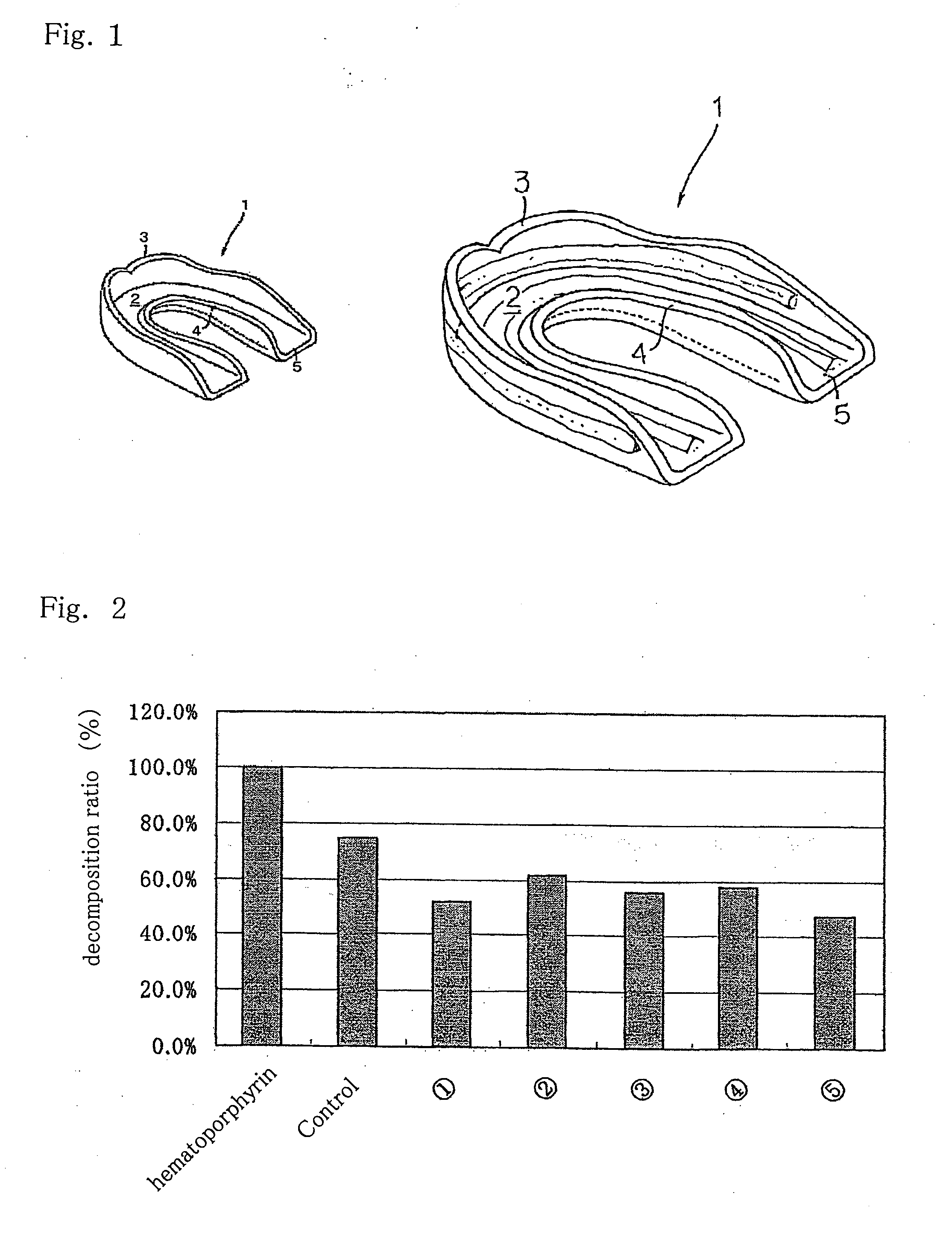Medical light emitting device
a light-emitting device and medical technology, applied in the field of medical light-emitting devices, can solve the problems of tooth discoloration and tooth discoloration, and achieve the effect of easy and safe irradiation with ligh
- Summary
- Abstract
- Description
- Claims
- Application Information
AI Technical Summary
Benefits of technology
Problems solved by technology
Method used
Image
Examples
example 1
Mouthpieces Comprising a Variety of Illuminant and / or Fluorescence Substance
[0043] Plastic was mixed with illuminant and / or fluorescence substance listed below using a blend loader. Each of the resulting melted fluorescent resin materials was molded into a plate or mouthpiece shape. [0044] (1) ethylene-vinyl acetate copolymer: 75%; and strontium aluminum borate: 25% [0045] (2) polycarbonate: 79.9%; strontium aluminum borate: 20.0%; and blue dye: 0.1% [0046] (3) polyethylene: 69.8%; strontium aluminum borate: 30.0%; and red dye: 0.2% [0047] (4) PET: 70%; and strontium aluminum borate: 30.0% [0048] (5) polypropylene: 75%; strontium aluminum borate: 15.0%; and EVAL: 10% [0049] (6) cyclic polyolefin: 65%; and strontium aluminum borate: 35.0% [0050] (7) polyether sulphone: 70%; and strontium aluminum borate: 30% [0051] (8) vinyl chloride: 97%; and strontium aluminum borate: 3% [0052] (9) chemically polymerized resin: 55%; and strontium aluminum borate: 45.0% [0053] (10) photopolymerized...
examples 2
Mouthpieces Having a Variety of Illuminant and / or Fluorescence Substance Applied Thereto
[0056] Tooth-form-shaped molded products were used, to which the following materials were incorporated, injected, applied, or attached: the light-storing material (e.g., strontium aluminum borate) of Example 1; Ultra Glow (Nichia), which have been commercially available as party goods, etc.; Brightex (Tokyo Shiryo Insho KK); Keprus (Next 1 Co., Ltd.); PG; PB light-storing materials (α-FLASH) (LTI Corporation); bioluminescent / chemiluminescent agents such as illuminant using hydrogen peroxide, urea peroxide, hypoxanthine, and superoxide (which cause, for example, luminol, luciferin, lucigenin, MPEC, hyperoxalic acid ester (hyperoxalester), allyl oxalate, and trichlorophenyl oxalate luminescences) and illuminant using calcium (which cause an aequorin luminescence); and Cyalume (cyanamide; Omniglow) or Lumica light, which have been commercially available as party goods, etc. [0057] (1) A sheet made ...
examples 3
[0062] A hematoporphyrin solution (2 ml) adjusted to 100 ppm was mixed with 1 g of hydroxyapatite. A colored substance was obtained. To the colored substance, approximately 2 ml of a hydrogen peroxide solution was added, following which mixing took place. The resultant was applied to resin samples. Then, each sample was covered with a small box. 15 minutes thereafter, the colored substance on each sample was collected and subjected to centrifugal separation. Each of the obtained supernatants was subjected to determination using a spectrophotometer. The results are shown in FIG. 2.
[0063] In FIG. 2, results of following cases are shown: control: a petri dish; (1): a sample in a petri dish to the bottom side of which Lumica light was attached; (2): a sample in a petri dish to the bottom side of which Brightex was attached; (3): a sample in a petri dish to the bottom side of which Ultra Glow was attached; (4): a sample in a petri dish to the bottom side of which Keprus was attached; an...
PUM
 Login to View More
Login to View More Abstract
Description
Claims
Application Information
 Login to View More
Login to View More - R&D
- Intellectual Property
- Life Sciences
- Materials
- Tech Scout
- Unparalleled Data Quality
- Higher Quality Content
- 60% Fewer Hallucinations
Browse by: Latest US Patents, China's latest patents, Technical Efficacy Thesaurus, Application Domain, Technology Topic, Popular Technical Reports.
© 2025 PatSnap. All rights reserved.Legal|Privacy policy|Modern Slavery Act Transparency Statement|Sitemap|About US| Contact US: help@patsnap.com


